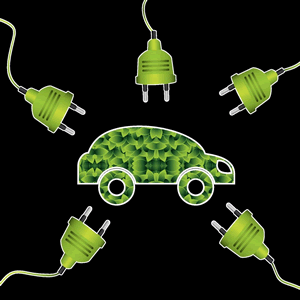Complementary Technologies for the Electric Vehicle Revolution
Wireless Level 2 vehicle-charging stations are an ideal solution for fast-approaching driverless vehicle technologies.
Randy Sumner, Director of Global Hybrid and Electric Vehicle Business and Technology Development, Delphi Automotive
 The global race to be the first company to bring a fully autonomous vehicle to the marketplace depends on a number of both hardware and software systems and subsystems coming together. We’re anticipating the mainstream integration of features including sensor fusion (e.g., integrating LiDAR, cameras, radar), active safety, a dramatic increase in connectivity, and engine software controls for cutting emissions and improving performance.
The global race to be the first company to bring a fully autonomous vehicle to the marketplace depends on a number of both hardware and software systems and subsystems coming together. We’re anticipating the mainstream integration of features including sensor fusion (e.g., integrating LiDAR, cameras, radar), active safety, a dramatic increase in connectivity, and engine software controls for cutting emissions and improving performance.
However, we are also witnessing a market convergence of this autonomy with electric vehicles. These are two significant disruptors to the automotive status quo that add to system complexity in terms of high voltages, power electronics, battery packs, and charging capabilities.
Adequately addressing all of these factors requires a robust vehicle architecture. The degree to which future cars are able to avoid accidents, pollute, or contribute to congestion will be gated by what the readers of this article — the vehicle architecture supply community — contribute to their designs. Autonomous vehicles will need to move information 10 times faster than today, and electric vehicles will command power levels significantly higher than most consumers’ homes. Converging these needs becomes a tall order and requires a radical change in the way we think.
Consider vehicle charging for driverless pods in the early part of the next decade, for example. If there is no driver, who will charge the vehicle when the battery runs down?
Since Delphi is one of the largest suppliers of charging systems in the world, we think about this a lot. For instance, we make OEM-supplied 120VAC Level 1 and 240VAC Level 2 portable plug-in chargers for all standards in all regions of the world, as well as supply charge coupler connectors and cords to Level 2 infrastructure charging suppliers for homes, workplaces, and commercial applications.
In each of these applications, users have to physically connect the charger to their vehicle. So, who will do this when cars are finally autonomous and no one is driving? Think about it; fully autonomous cars will be able to do incredible things, like navigate heavy urban traffic or avoid or even anticipate incipient accidents. How, though, will they fuel themselves?
If autonomous vehicles are electrified vehicles, a driver won’t be exiting the car to plug in and recharge. Instead, autonomous vehicles will likely be programmed to either return home or find the nearest public wireless charging station to recharge. No human would need to be involved.
Wireless charging is already known in the world of consumer electronics. For autonomous electric vehicles, the basic components include a power station, a ground pad with a source coil that delivers the charge, a vehicle coil that takes the charge, and onboard electronics that convert and provide the power to the car’s battery pack. When power levels are scaled to the needs of wireless Level 2 charging (3.3kW to 11kW), however, concerns that would be fairly marginal with consumer electronics become much more serious.
We need to be able to account for the random housecat that sneaks into the garage and onto the pad. We need to address the safety concerns involved with having strong electromagnetic fields in close proximity to people. For example, these fields will need to be well below the safety standards for pacemakers or other medical devices and yet strong enough to power a vehicle. Finally, we will have to account for the autonomous vehicle itself with regards to electromagnetic compatibility, as infotainment systems, battery pack controls, a multitude of sensors, power electronics, and other sensitive electronics will also need consideration and protection.
Yet, many owners of non-autonomous electrified vehicles, such as the Tesla Model S, Chevy Volt, Ford Fusion Energi, or Toyota’s Prius Plug-In, would also benefit from a wireless charging pad system. As a Chevy Volt owner myself, I’d be lying if I didn’t say there were times when I just forgot to plug in my vehicle. Of course, the gas-powered range extender keeps me from being stranded, but what if I were driving a fully electric Bolt and forgot to plug in? These are just a few of the things we, as an industry, need to consider as we move closer to a future of wireless charging.
Make no mistake: This technology is coming. Vehicle OEMs and ride-sharing companies all over the world have expressed more than a little interest in this. So, it will be critically important to confirm the interoperability of different suppliers’ pads with different vehicle coils to enable universal charging in public spaces. Luckily, the Society of Automotive Engineers is well on their way to coming up with an interoperability standard.
What we, as an industry, should try to avoid is the hodgepodge of connector standards that we see with both Level 1 and Level 2 chargers (SAE, European, and Chinese standards) and Level 3 fast charging (CHAdeMO and SAE Combo/CCS).
Although it’s great that top tier automotive interconnect suppliers like Delphi, can provide plug-in chargers with couple connections and vehicle receptacles for every global standard, the industry as a whole would experience faster growth if we agreed in advance upon a standard for automotive wireless charging. This drives our decision to aggressively pursue the development of this kind of charging technology. Infrastructure providers and workplaces will present a huge opportunity to bring these charging pads to market as soon as possible.
While Level 2 charging systems will no doubt be costlier than plug-in stations due to increased electronics content, Delphi has a vision for the future, and we believe that the ease and convenience of wireless charging pads will be priceless.
Recently posted:
[related_posts limit=”10″]






